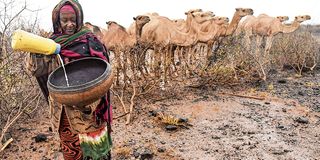A toast for milk as world expected to mark day on June 1

Tura Buke, a pastoralist in Marsabit County just after milking her camels. Global demand for camel milk is rising due to the many health benefits that the milk has. PHOTO | FILE | NATION MEDIA GROUP
What you need to know:
- The day, which was set aside 20 years ago, recognises the rising importance of milk, especially in the wake of the Covid-19 pandemic that is ravaging the world.
- The cow dairy industry had for long been considered the sole well-organised and powerful force in provision of dairy products, while the camel milk private sector was mostly established in the United Arab Emirates (UAE), Saudi Arabia and Mauritania.
- Drought and the fact that 89 per cent of Kenya is classified as arid and semi-arid means many are shifting from cows to camels, even in southern Kenya.
- North America is expected to grow the fastest as consumers with diabetes switch to camel milk to better control sugar levels.
On June 1, Kenyan milk producers, experts and consumers will join their counterparts across the globe in marking the World Milk Day.
The day, which was set aside 20 years ago, recognises the rising importance of milk, especially in the wake of the Covid-19 pandemic that is ravaging the world.
Among those to celebrate is a global coalition of camel milk consumers, experts and dairy consumers across the world, who will raise their milk glasses to mark the occasion – albeit virtually.
“There are three million camels and five million pastoralists who rely on camels for their livelihoods but they cannot make a living due to Covid-19 restrictions,” said Prof George Chege of the University of Nairobi, noting that these are some of the people the day will be dedicated to.
The cow dairy industry had for long been considered the sole well-organised and powerful force in provision of dairy products, while the camel milk private sector was mostly established in the United Arab Emirates (UAE), Saudi Arabia and Mauritania.
But with climate change and growing consumer concerns about ethics and farming, camel herders and milk producers are expanding worldwide and the camel milk industry, which is currently undervalued, could rival other foreign exchange earners in Kenya, he said.
Drought and the fact that 89 per cent of Kenya is classified as arid and semi-arid means many are shifting from cows to camels, even in southern Kenya, according to Dr James Chomba Njanja, the vice-chairman of the Kenya Camel Association.
Other African countries where camels were rarely kept before, such as Uganda and Tanzania, are also switching to camel-keeping, he said.
CAMEL MILK SALES ARE GROWING
Much interest has been given to cattle milk, but with nascent markets globally, camel milk sales are growing, as interest in the more natural, immune-boosting, climate-friendly and healthy dairy option which comes as both milk and as an active ingredient in camel milk products, picks up.
Dr Bernard Faye, a veterinarian and chairman of the International Society of Camelid Research and Development (ISOCARD), an organisation seeking to promote the welfare of camelids, indicated the global camel market is projected to grow at more than 10 per cent for the next decade.
“So there will be more camel milk in the future,” he said.
North America is expected to grow the fastest as consumers with diabetes switch to camel milk to better control sugar levels.
Currently, the Middle East and Africa dominate camel milk markets, accounting for more than 60 per cent of the global camel livestock revenue.
In the region, Somalia, Ethiopia, Sudan and Kenya consume the most camel milk while Saudi Arabia is the largest market in the world at around 33 litres per year, per capita.
“Camel milk is essentially the key source of nutrition for people in Northeastern Kenya and for thousands of refugees. And with climate challenges in counties along the equator including Kenya, more commercial dairy farmers are diversifying to camels as they do better in tough, drought-ridden, hot climates and browse on prickly bushes and shrubs that most farm animals avoid,” said Prof Chege.
For Rachel Kinyua, though, a successful dairy farmer in Meru County, milk is a boon. She earns its benefits from her 15 dairy cows, getting 160 litres daily from her six milkers
She sells the commodity at Sh34 per litre to Nyaki Farmers’ Co-operative Society, an affiliate of Meru Union Dairy Co-operative Society.
Rachel has been working with the International Centre for Tropical Agriculture (CIAT) – now part of the Alliance of Bioversity International and CIAT – and the Netherlands Development Organisation (SNV) in cultivating improved forages.
These forages are high-yielding, more palatable and nutritious and respond better to biotic and abiotic stresses as well as improve livestock production of milk and meat.





